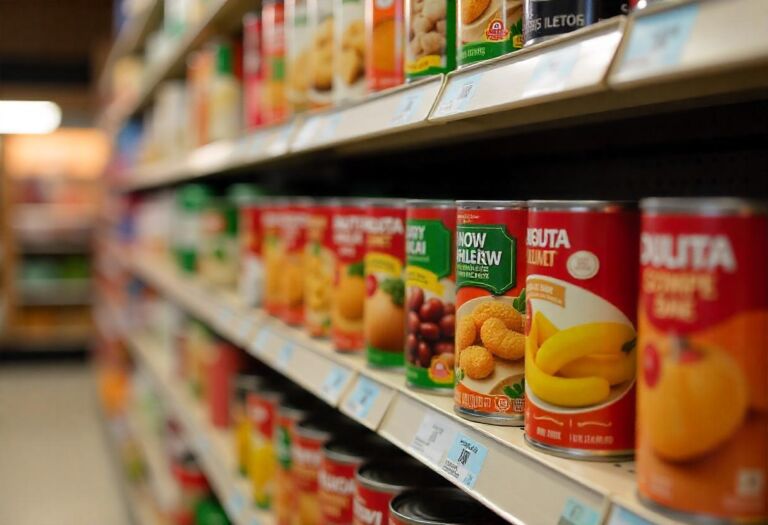President Donald Trump’s return to office has revived one of his most controversial economic weapons: tariffs. Framed as a patriotic strategy to protect American manufacturing, especially the steel industry, Trump’s decision to double tariffs on imported steel and aluminum is already backfiring, hitting two groups he claims to champion: farmers and working-class families. The president ordered the tariffs to be increased from 25 percent to 50 percent ad valorem.
While steel and aluminum might seem distant from your grocery bill or a farmer’s balance sheet, they are embedded in nearly every part of the food system, from the cans that hold your soup to the tractors that harvest your grain. These new tariffs are a direct tax on American consumers and producers.
Steel tariffs, grocery prices, and everyday Americans
Steel and aluminum are core components of food packaging. Canned vegetables, baby formula, soup, pet food, and many other products depend on these metals. U.S. manufacturers rely heavily on imports because domestic supply can’t meet demand. But under Trump’s new tariff policy, the cost of tin mill steel will spike.
The Can Manufacturers Institute warns that this increase will translate into higher grocery prices. Food companies like The Campbell Co. and ConAgra are already expecting that they will have to pass at least some of the increase along to customers. It comes after years of pandemic- and inflation-driven price hikes. In other words, Trump’s tariffs will make inflation worse, not better — particularly for low-income families who rely on shelf-stable, affordable food.
Farmers: Collateral damage in a trade war
While consumers will feel the sting in the grocery aisle, farmers will also be absorbing a heavy blow. The steel and aluminum needed for equipment like tractors, sprayers, and grain bins will carry a much steeper price tag. As a result, the agricultural equipment industry is entering a holding pattern. Farmers are pausing major purchases. Equipment dealers are worried. Manufacturers are bracing for impact.
In a Tractor Zoom survey of 25 equipment dealers:
- 45 percent said tariffs will negatively affect their business
- Nearly 40 percent rated their concern level at 4 out of 5
- More than half expect increased demand for used equipment, as farmers avoid buying new due to high costs
No company illustrates the damage better than John Deere. The iconic American manufacturer said in May it expects more than $500 million in tariff-related costs this fiscal year alone. It has already incurred $100 million in the latest quarter and anticipates at least $400 million more by October. And that’s on top of a tough year: net income fell 30 percent and net sales dropped 19 percent from the prior year.
Deere is doing what it can to manage the impact of the tariffs, including:
- Considering shifting production away from tariff-hit regions like China and the EU
- Renegotiating supplier contracts to find cost savings
- Applying for U.S.-Mexico-Canada Agreement (USMCA) certificates to claim tariff exemptions on goods that technically qualify
But ultimately, the company may have no choice but to raise prices. It has already announced 2 percent to 4 percent increases for its 2026 model-year planters and sprayers. And though Deere has avoided midyear surcharge hikes so far, it “reserves the right to adjust pricing” as the tariff situation evolves.
That prospect leaves farmers — already grappling with lower crop prices and rising input costs — facing yet another financial squeeze.
Negative unintended consequences of tariffs
Trump promised relief at the checkout aisle and pledged to stand up for American workers and farmers. The numbers tell a different story, however:
- $500 million in added costs for just one U.S. equipment maker
- 50 percent tariffs on essential inputs like steel, which will raise grocery prices
- Farmers and equipment dealers delaying or canceling investments
- A patchwork of retaliatory tariffs that threaten U.S. agricultural exports abroad
Manufacturers like Deere and others are still investing in U.S. operations, but they’ve made it clear that they need certainty, not chaos.
Trump’s steel tariffs are a textbook example of policy that sounds good in a stump speech but wreaks havoc in the real world. He promised to help farmers and lower food prices. Instead, he’s delivering the opposite: higher equipment costs, delayed investments, and more expensive groceries.
The post When steel gets costly, so does dinner first appeared on John Locke Foundation.
Click this link for the original source of this article.
Author: Kelly Lester
This content is courtesy of, and owned and copyrighted by, https://www.johnlocke.org and its author. This content is made available by use of the public RSS feed offered by the host site and is used for educational purposes only. If you are the author or represent the host site and would like this content removed now and in the future, please contact USSANews.com using the email address in the Contact page found in the website menu.








